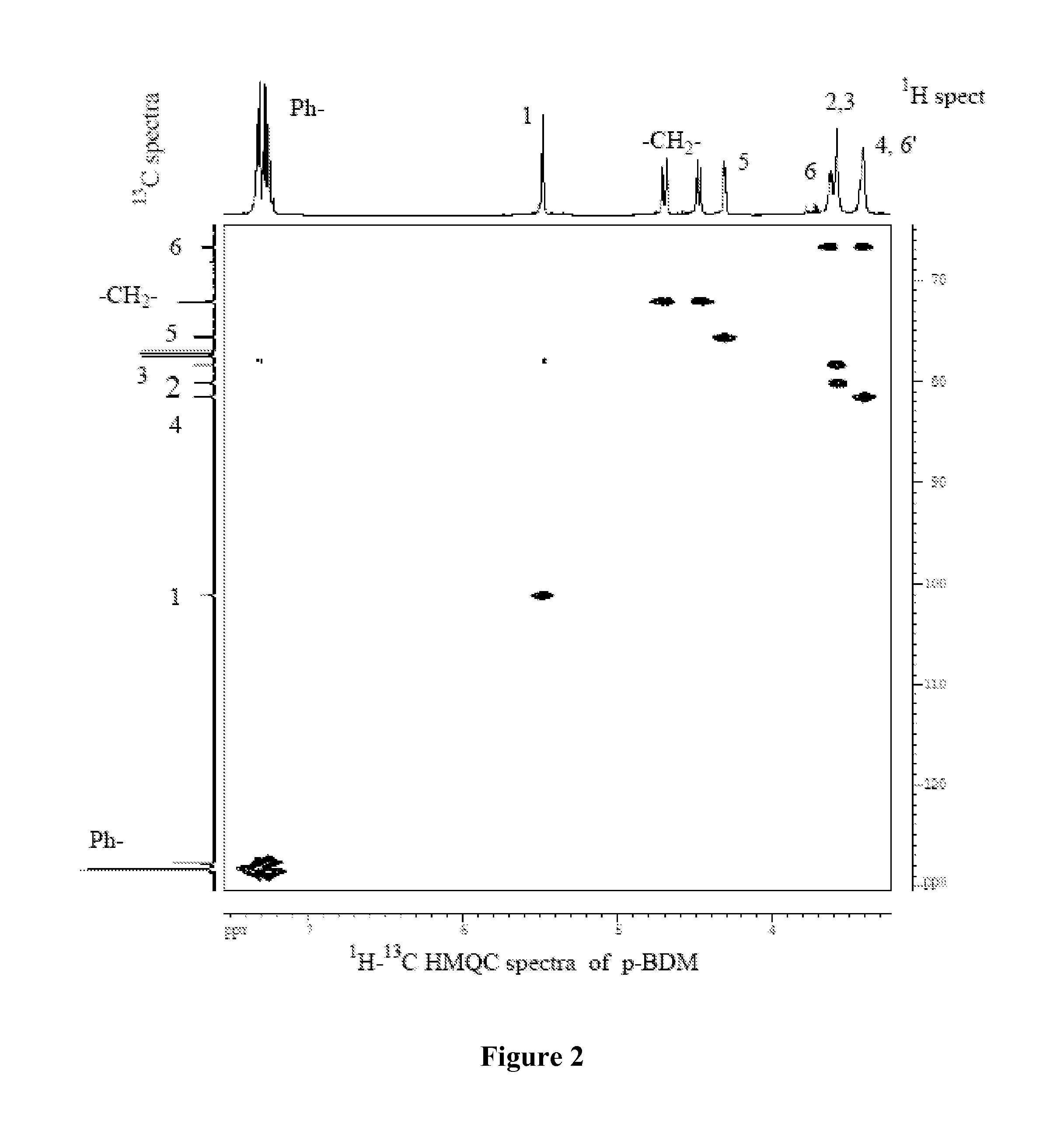Water-Soluble Carbohydrate Polyethers
a technology of water-soluble carbohydrate and polyether, which is applied in the direction of sugar derivates, organic chemistry, chemistry apparatus and processes, etc., can solve the problems of ineffectiveness of enantiomers of opposite configurations, undesirable side effects, and less ideal chromatographic methods based on such media
- Summary
- Abstract
- Description
- Claims
- Application Information
AI Technical Summary
Benefits of technology
Problems solved by technology
Method used
Image
Examples
example 1
Synthesis of 1,6:3,4-dianhydro-2-O-p-toluenesulfonyl-β-D-galactopyranose (TDG) as Starting Material for D-mannopyranose Monomer Syntheses
[0107]To a solution of 162 g of levoglucosan in 500 mL of anhydrous pyridine and 500 mL of anhydrous acetone was added 400 g of p-toluenesulfonylchloride in small portions. The resulting reaction mixture was stirred at ambient temperature for 72 hrs after which time 1 L of chloroform and 1 L of water were added. The aqueous layer was separated and extracted with chloroform (2×200 mL). The combined chloroform extract was washed sequentially with water (3×1000 mL), 10% H2SO4 at pH 4 (2×850 mL), concentrated Na2CO3 (300 mL), water (3×500 mL) and reduced in vacuo to syrup. The syrup was dissolved in 1000 mL of anhydrous chloroform and 200 mL of anhydrous methanol and to this solution was added a solution of sodium methoxide (prepared from 69 g of sodium in anhydrous methanol) at ambient temperature in small portions and the resulting reaction mixture w...
example 2
Synthesis of 1,6:2,3-dianhydro-4-O-benzyl-β-D-mannopyranose (BDM)
[0108]To a solution of 28 g of TDG in 100 mL of benzene and 72 mL of benzyl alcohol in a flask equipped with a Dean-Stark water separator was added 3 g of p-toluenesulfonic acid monohydrate. The reaction mixture was heated to reflux for 5 hrs, while the progress of the reaction was monitored by TLC (CHCl3 / acetone, 9 / 1, v / v). After the ring-opening reaction was complete 100 mL of chloroform was added followed by addition of the solution of 6.9 g of sodium in 100 mL of anhydrous methanol and the progress of the reaction was monitored by TLC. After the ring-closing reaction was complete, chloroform (50 mL) and water (200 mL) were added and the organic layer was separated, extracted with water and reduced in vacuo to syrup. The syrup was distilled under high vacuum and crystallized from diethyl ether and recrystallized from anhydrous ether. Yield=14.43 g (62%); colorless crystals MP=60° C.; single spot on TLC; [α]D=−28° (C...
example 3
Synthesis of 1,6:2,3-dianhydro-4-O-decyl-β-D-mannopyranose (DDM)
[0109]To a solution of 30 g of TDG in 60 mL of benzene and 90 mL of 1-decanol in a flask equipped with a Dean-Stark water separator was added 3.1 g of p-toluenesulfonic acid monohydrate. The reaction mixture was heated to reflux for 5 hrs, while the progress of the reaction was monitored by TLC (CHCl3 / acetone, 9 / 1, v / v). After the ring-opening reaction was complete 100 mL of chloroform and 28 mL of methanol was added followed by addition of the solution of 3.5 g of sodium in 56 mL of anhydrous methanol and the progress of the reaction was monitored by TLC. After the ring-closing reaction was complete, chloroform (100 mL) and water (100 mL) was added and the organic layer was separated, extracted with water, and reduced in vacuo to syrup. Fractional distillation of syrup in high vacuum yielded 23.4 g (83%) of colorless viscous liquid, pure by HPLC., single spot on TLC; [α]D=−24.8° (CHCl3). Structure identification: 13C / 1...
PUM
| Property | Measurement | Unit |
|---|---|---|
| Weight | aaaaa | aaaaa |
| Weight | aaaaa | aaaaa |
| Fraction | aaaaa | aaaaa |
Abstract
Description
Claims
Application Information
 Login to View More
Login to View More - R&D Engineer
- R&D Manager
- IP Professional
- Industry Leading Data Capabilities
- Powerful AI technology
- Patent DNA Extraction
Browse by: Latest US Patents, China's latest patents, Technical Efficacy Thesaurus, Application Domain, Technology Topic, Popular Technical Reports.
© 2024 PatSnap. All rights reserved.Legal|Privacy policy|Modern Slavery Act Transparency Statement|Sitemap|About US| Contact US: help@patsnap.com










